Environmental Science: Sustainable Land Management Report Analysis
VerifiedAdded on 2022/11/23
|7
|1541
|245
Report
AI Summary
This report on sustainable land management in Australia addresses several key issues. It begins by examining the compatibility of tourism goals with protected areas, followed by an exploration of Ecological Sustainable Development (ESD) principles. The report then delves into alternatives to fossil fuels, highlighting renewable energy sources like wind, solar, and wave energy, and their implementation in Australia. Finally, it analyzes the problem of plastic pollution, discussing its local and global consequences, and references a recent media article to support the claims. The report underscores the importance of sustainable practices and the need for government action to mitigate environmental damage, emphasizing the interconnectedness of environmental challenges and the role of various stakeholders in addressing them.
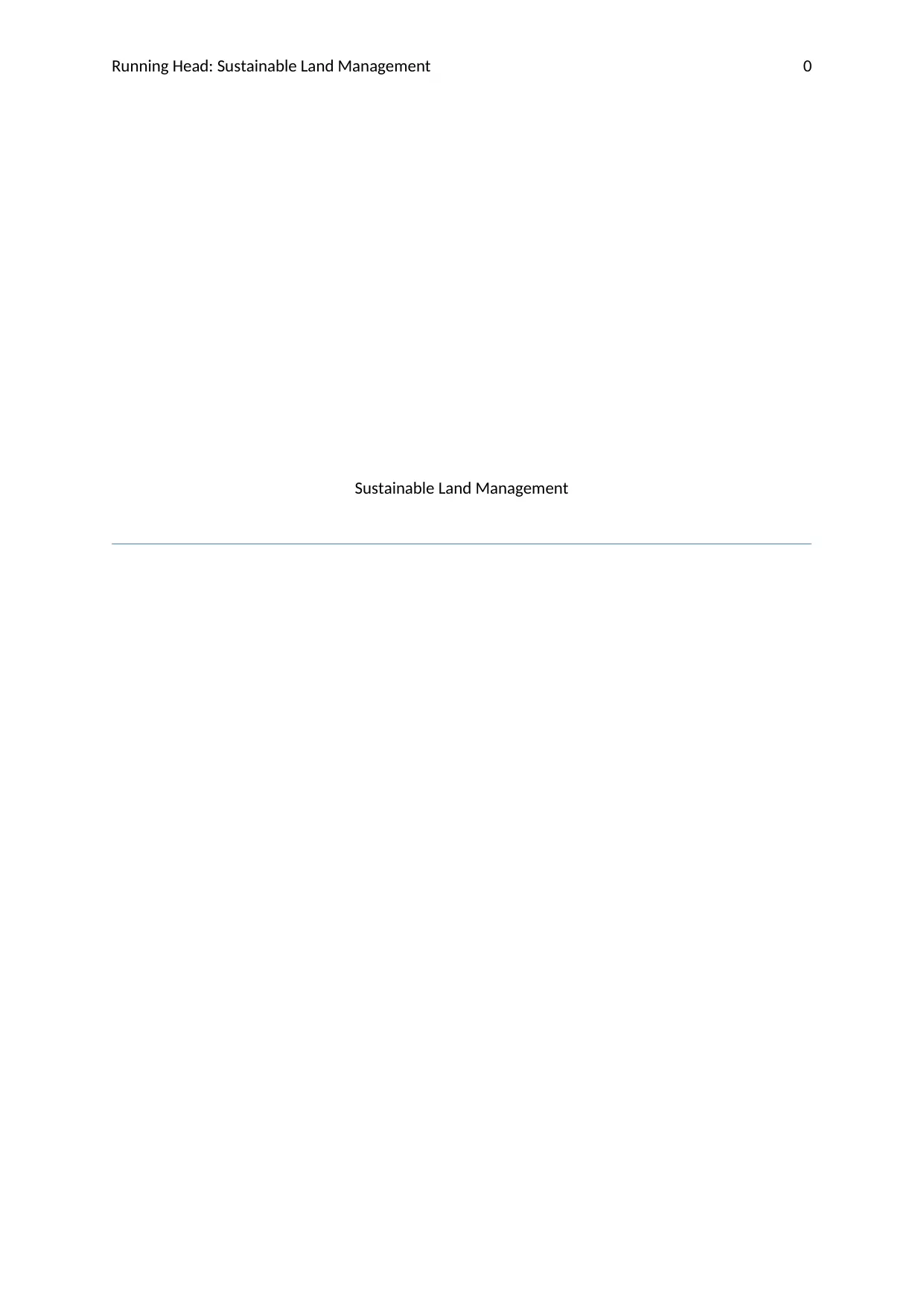
Running Head: Sustainable Land Management 0
Sustainable Land Management
Sustainable Land Management
Paraphrase This Document
Need a fresh take? Get an instant paraphrase of this document with our AI Paraphraser
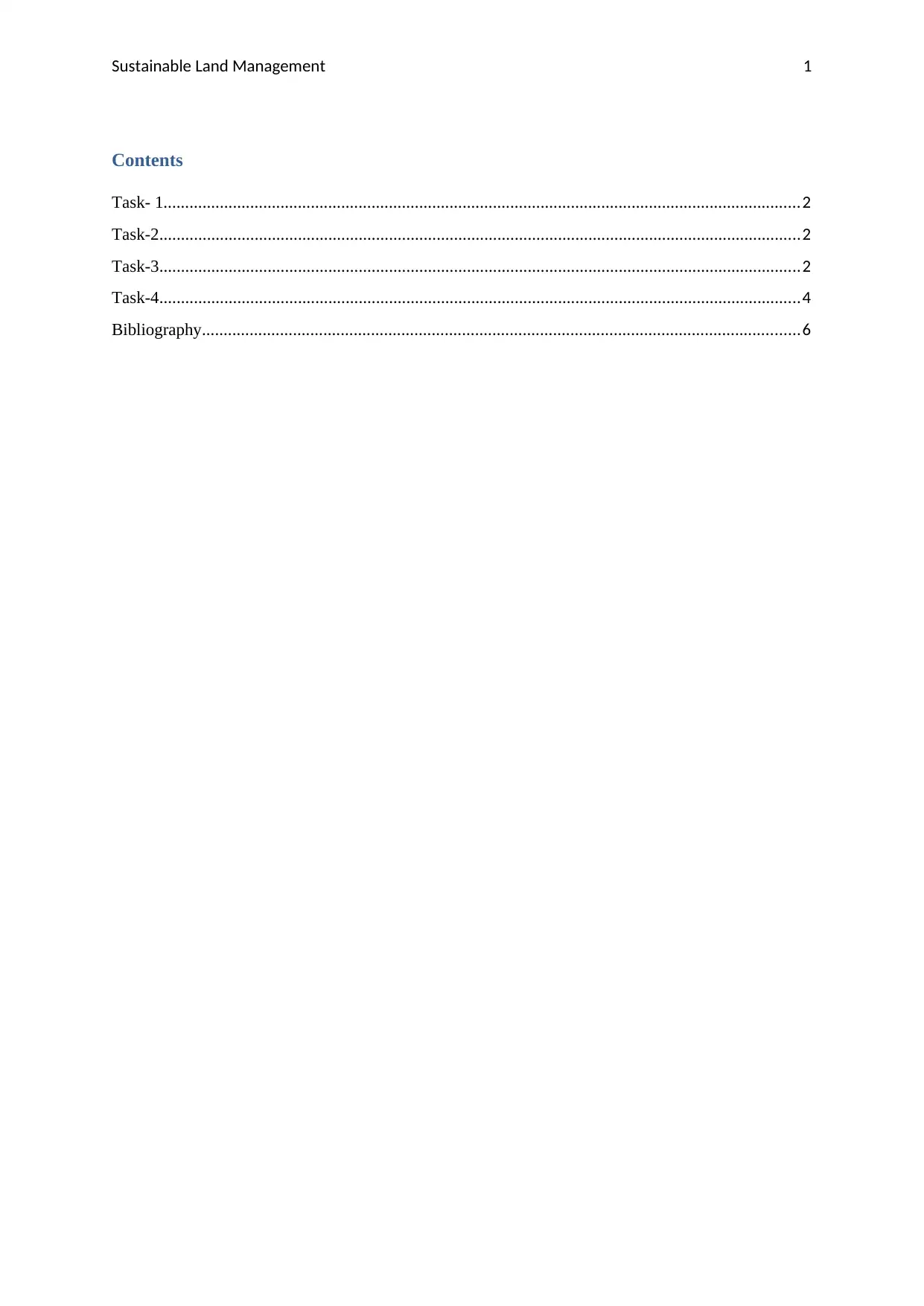
Sustainable Land Management 1
Contents
Task- 1...................................................................................................................................................2
Task-2....................................................................................................................................................2
Task-3....................................................................................................................................................2
Task-4....................................................................................................................................................4
Bibliography..........................................................................................................................................6
Contents
Task- 1...................................................................................................................................................2
Task-2....................................................................................................................................................2
Task-3....................................................................................................................................................2
Task-4....................................................................................................................................................4
Bibliography..........................................................................................................................................6
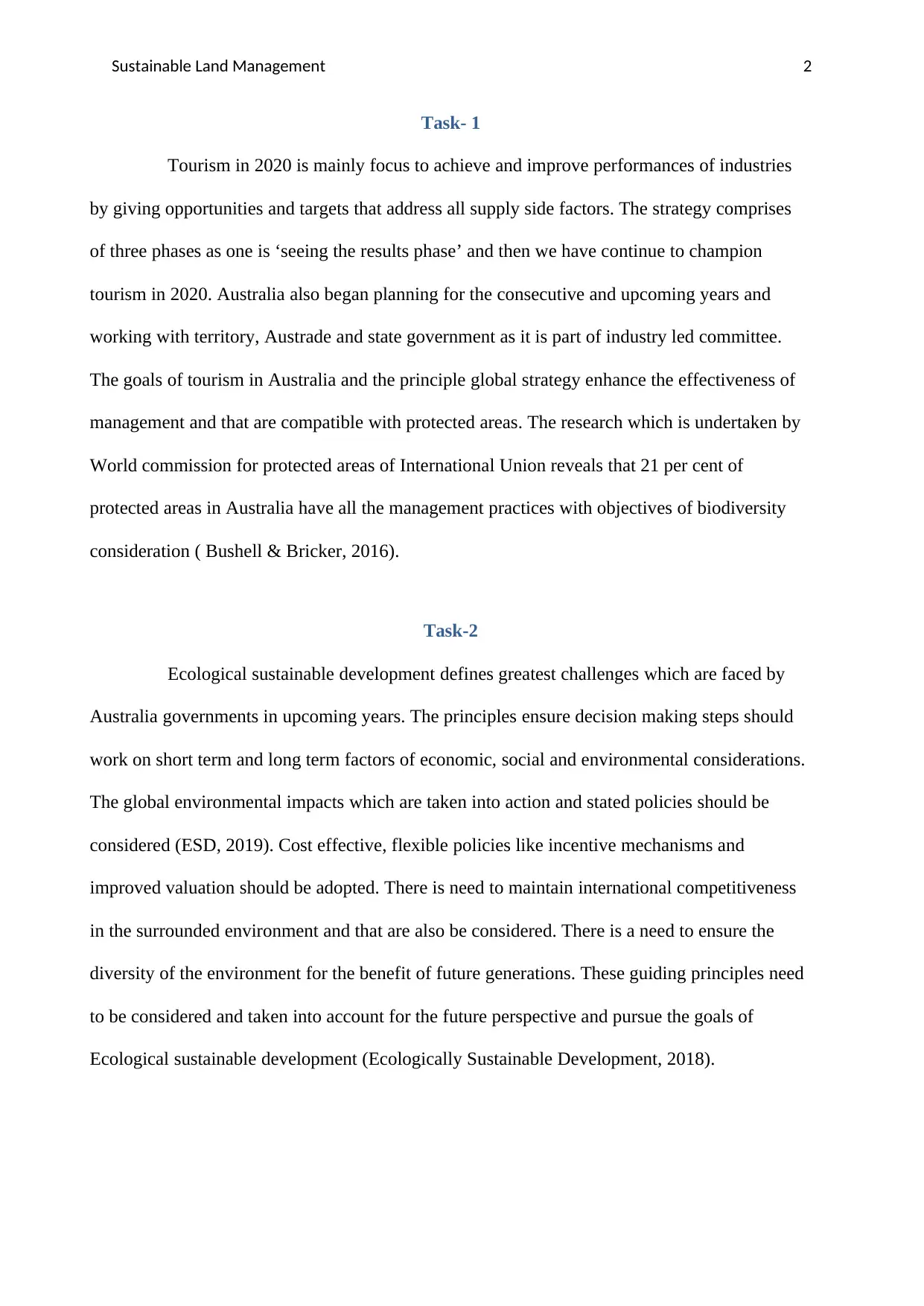
Sustainable Land Management 2
Task- 1
Tourism in 2020 is mainly focus to achieve and improve performances of industries
by giving opportunities and targets that address all supply side factors. The strategy comprises
of three phases as one is ‘seeing the results phase’ and then we have continue to champion
tourism in 2020. Australia also began planning for the consecutive and upcoming years and
working with territory, Austrade and state government as it is part of industry led committee.
The goals of tourism in Australia and the principle global strategy enhance the effectiveness of
management and that are compatible with protected areas. The research which is undertaken by
World commission for protected areas of International Union reveals that 21 per cent of
protected areas in Australia have all the management practices with objectives of biodiversity
consideration ( Bushell & Bricker, 2016).
Task-2
Ecological sustainable development defines greatest challenges which are faced by
Australia governments in upcoming years. The principles ensure decision making steps should
work on short term and long term factors of economic, social and environmental considerations.
The global environmental impacts which are taken into action and stated policies should be
considered (ESD, 2019). Cost effective, flexible policies like incentive mechanisms and
improved valuation should be adopted. There is need to maintain international competitiveness
in the surrounded environment and that are also be considered. There is a need to ensure the
diversity of the environment for the benefit of future generations. These guiding principles need
to be considered and taken into account for the future perspective and pursue the goals of
Ecological sustainable development (Ecologically Sustainable Development, 2018).
Task- 1
Tourism in 2020 is mainly focus to achieve and improve performances of industries
by giving opportunities and targets that address all supply side factors. The strategy comprises
of three phases as one is ‘seeing the results phase’ and then we have continue to champion
tourism in 2020. Australia also began planning for the consecutive and upcoming years and
working with territory, Austrade and state government as it is part of industry led committee.
The goals of tourism in Australia and the principle global strategy enhance the effectiveness of
management and that are compatible with protected areas. The research which is undertaken by
World commission for protected areas of International Union reveals that 21 per cent of
protected areas in Australia have all the management practices with objectives of biodiversity
consideration ( Bushell & Bricker, 2016).
Task-2
Ecological sustainable development defines greatest challenges which are faced by
Australia governments in upcoming years. The principles ensure decision making steps should
work on short term and long term factors of economic, social and environmental considerations.
The global environmental impacts which are taken into action and stated policies should be
considered (ESD, 2019). Cost effective, flexible policies like incentive mechanisms and
improved valuation should be adopted. There is need to maintain international competitiveness
in the surrounded environment and that are also be considered. There is a need to ensure the
diversity of the environment for the benefit of future generations. These guiding principles need
to be considered and taken into account for the future perspective and pursue the goals of
Ecological sustainable development (Ecologically Sustainable Development, 2018).
⊘ This is a preview!⊘
Do you want full access?
Subscribe today to unlock all pages.

Trusted by 1+ million students worldwide
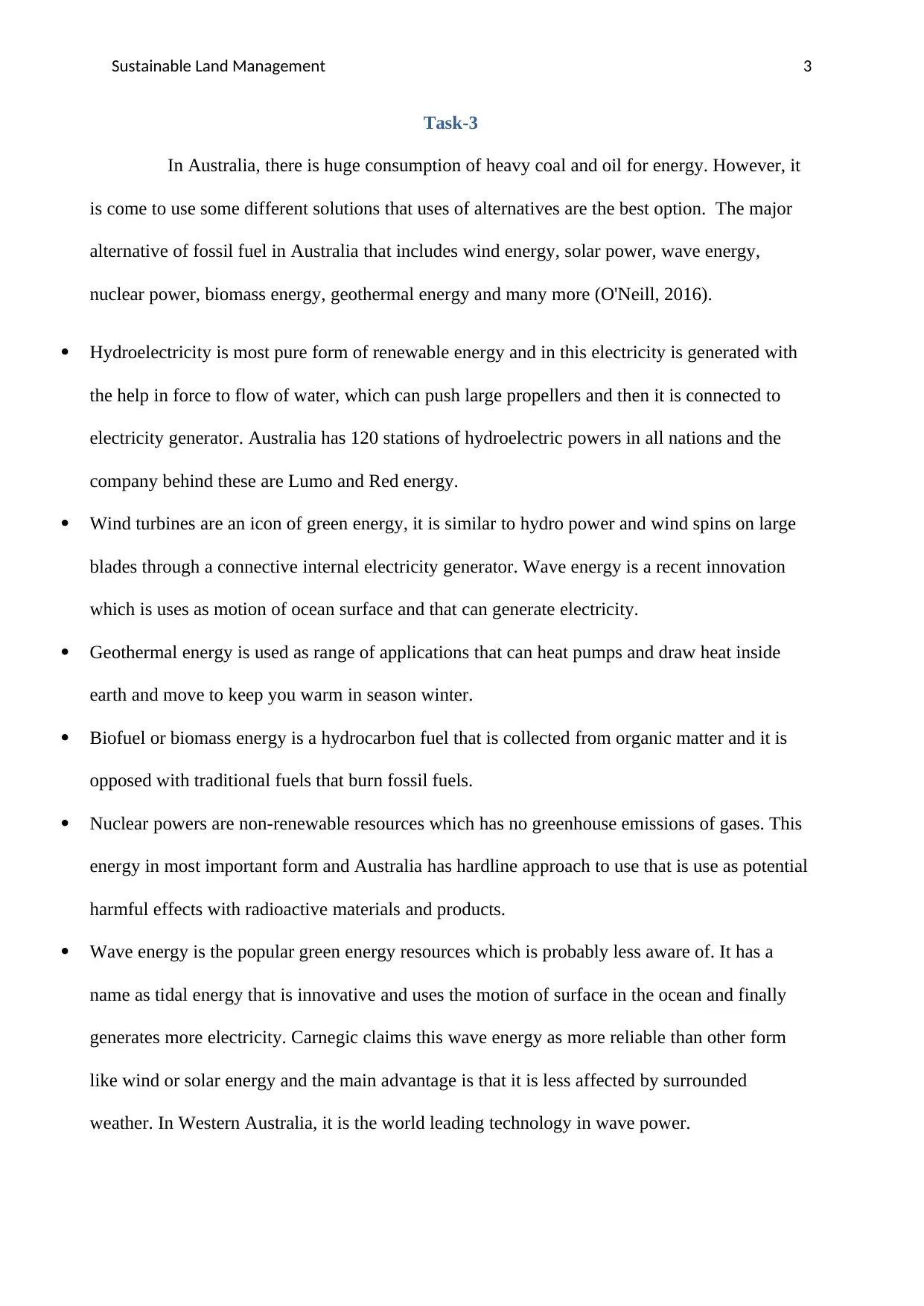
Sustainable Land Management 3
Task-3
In Australia, there is huge consumption of heavy coal and oil for energy. However, it
is come to use some different solutions that uses of alternatives are the best option. The major
alternative of fossil fuel in Australia that includes wind energy, solar power, wave energy,
nuclear power, biomass energy, geothermal energy and many more (O'Neill, 2016).
Hydroelectricity is most pure form of renewable energy and in this electricity is generated with
the help in force to flow of water, which can push large propellers and then it is connected to
electricity generator. Australia has 120 stations of hydroelectric powers in all nations and the
company behind these are Lumo and Red energy.
Wind turbines are an icon of green energy, it is similar to hydro power and wind spins on large
blades through a connective internal electricity generator. Wave energy is a recent innovation
which is uses as motion of ocean surface and that can generate electricity.
Geothermal energy is used as range of applications that can heat pumps and draw heat inside
earth and move to keep you warm in season winter.
Biofuel or biomass energy is a hydrocarbon fuel that is collected from organic matter and it is
opposed with traditional fuels that burn fossil fuels.
Nuclear powers are non-renewable resources which has no greenhouse emissions of gases. This
energy in most important form and Australia has hardline approach to use that is use as potential
harmful effects with radioactive materials and products.
Wave energy is the popular green energy resources which is probably less aware of. It has a
name as tidal energy that is innovative and uses the motion of surface in the ocean and finally
generates more electricity. Carnegic claims this wave energy as more reliable than other form
like wind or solar energy and the main advantage is that it is less affected by surrounded
weather. In Western Australia, it is the world leading technology in wave power.
Task-3
In Australia, there is huge consumption of heavy coal and oil for energy. However, it
is come to use some different solutions that uses of alternatives are the best option. The major
alternative of fossil fuel in Australia that includes wind energy, solar power, wave energy,
nuclear power, biomass energy, geothermal energy and many more (O'Neill, 2016).
Hydroelectricity is most pure form of renewable energy and in this electricity is generated with
the help in force to flow of water, which can push large propellers and then it is connected to
electricity generator. Australia has 120 stations of hydroelectric powers in all nations and the
company behind these are Lumo and Red energy.
Wind turbines are an icon of green energy, it is similar to hydro power and wind spins on large
blades through a connective internal electricity generator. Wave energy is a recent innovation
which is uses as motion of ocean surface and that can generate electricity.
Geothermal energy is used as range of applications that can heat pumps and draw heat inside
earth and move to keep you warm in season winter.
Biofuel or biomass energy is a hydrocarbon fuel that is collected from organic matter and it is
opposed with traditional fuels that burn fossil fuels.
Nuclear powers are non-renewable resources which has no greenhouse emissions of gases. This
energy in most important form and Australia has hardline approach to use that is use as potential
harmful effects with radioactive materials and products.
Wave energy is the popular green energy resources which is probably less aware of. It has a
name as tidal energy that is innovative and uses the motion of surface in the ocean and finally
generates more electricity. Carnegic claims this wave energy as more reliable than other form
like wind or solar energy and the main advantage is that it is less affected by surrounded
weather. In Western Australia, it is the world leading technology in wave power.
Paraphrase This Document
Need a fresh take? Get an instant paraphrase of this document with our AI Paraphraser
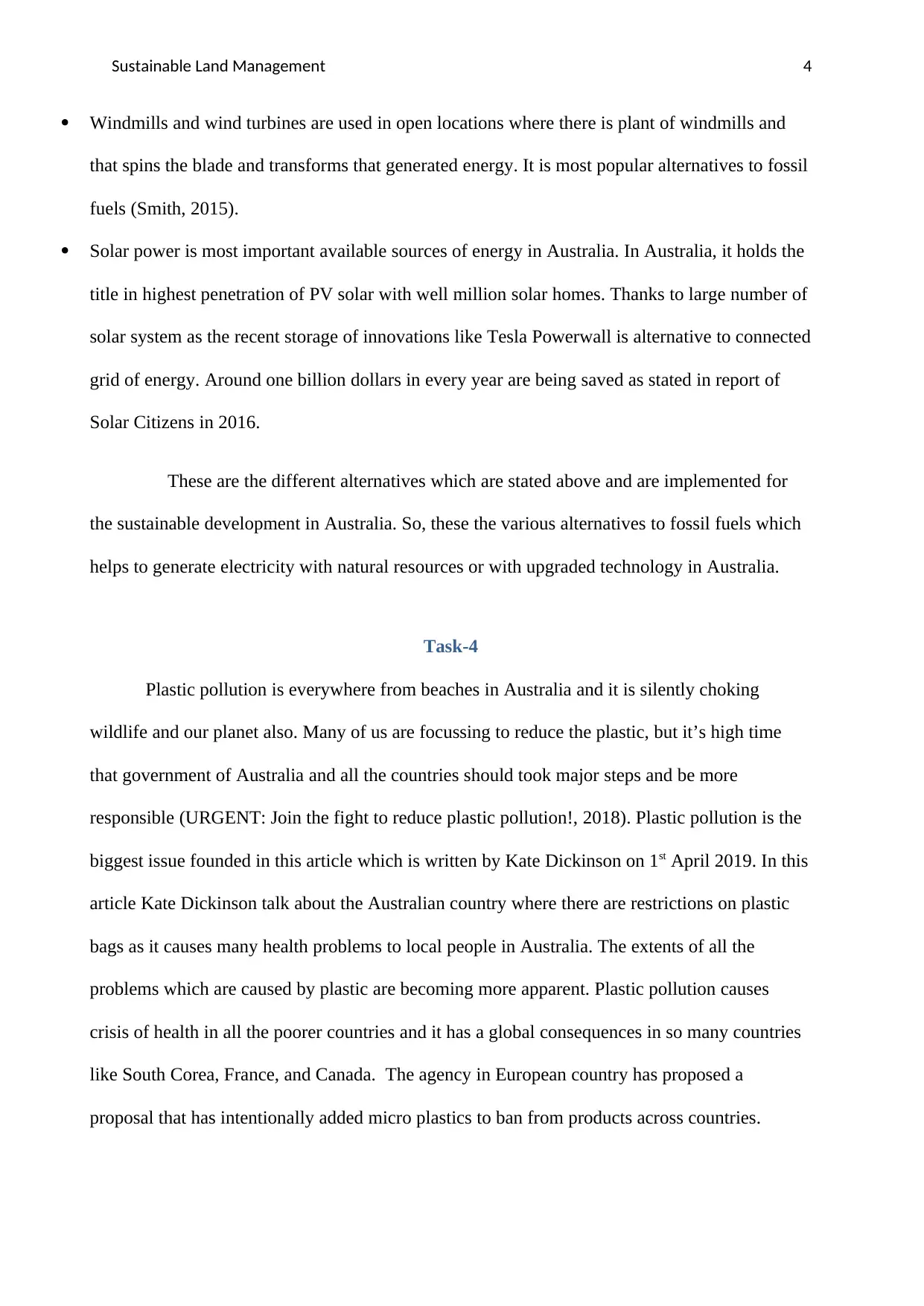
Sustainable Land Management 4
Windmills and wind turbines are used in open locations where there is plant of windmills and
that spins the blade and transforms that generated energy. It is most popular alternatives to fossil
fuels (Smith, 2015).
Solar power is most important available sources of energy in Australia. In Australia, it holds the
title in highest penetration of PV solar with well million solar homes. Thanks to large number of
solar system as the recent storage of innovations like Tesla Powerwall is alternative to connected
grid of energy. Around one billion dollars in every year are being saved as stated in report of
Solar Citizens in 2016.
These are the different alternatives which are stated above and are implemented for
the sustainable development in Australia. So, these the various alternatives to fossil fuels which
helps to generate electricity with natural resources or with upgraded technology in Australia.
Task-4
Plastic pollution is everywhere from beaches in Australia and it is silently choking
wildlife and our planet also. Many of us are focussing to reduce the plastic, but it’s high time
that government of Australia and all the countries should took major steps and be more
responsible (URGENT: Join the fight to reduce plastic pollution!, 2018). Plastic pollution is the
biggest issue founded in this article which is written by Kate Dickinson on 1st April 2019. In this
article Kate Dickinson talk about the Australian country where there are restrictions on plastic
bags as it causes many health problems to local people in Australia. The extents of all the
problems which are caused by plastic are becoming more apparent. Plastic pollution causes
crisis of health in all the poorer countries and it has a global consequences in so many countries
like South Corea, France, and Canada. The agency in European country has proposed a
proposal that has intentionally added micro plastics to ban from products across countries.
Windmills and wind turbines are used in open locations where there is plant of windmills and
that spins the blade and transforms that generated energy. It is most popular alternatives to fossil
fuels (Smith, 2015).
Solar power is most important available sources of energy in Australia. In Australia, it holds the
title in highest penetration of PV solar with well million solar homes. Thanks to large number of
solar system as the recent storage of innovations like Tesla Powerwall is alternative to connected
grid of energy. Around one billion dollars in every year are being saved as stated in report of
Solar Citizens in 2016.
These are the different alternatives which are stated above and are implemented for
the sustainable development in Australia. So, these the various alternatives to fossil fuels which
helps to generate electricity with natural resources or with upgraded technology in Australia.
Task-4
Plastic pollution is everywhere from beaches in Australia and it is silently choking
wildlife and our planet also. Many of us are focussing to reduce the plastic, but it’s high time
that government of Australia and all the countries should took major steps and be more
responsible (URGENT: Join the fight to reduce plastic pollution!, 2018). Plastic pollution is the
biggest issue founded in this article which is written by Kate Dickinson on 1st April 2019. In this
article Kate Dickinson talk about the Australian country where there are restrictions on plastic
bags as it causes many health problems to local people in Australia. The extents of all the
problems which are caused by plastic are becoming more apparent. Plastic pollution causes
crisis of health in all the poorer countries and it has a global consequences in so many countries
like South Corea, France, and Canada. The agency in European country has proposed a
proposal that has intentionally added micro plastics to ban from products across countries.
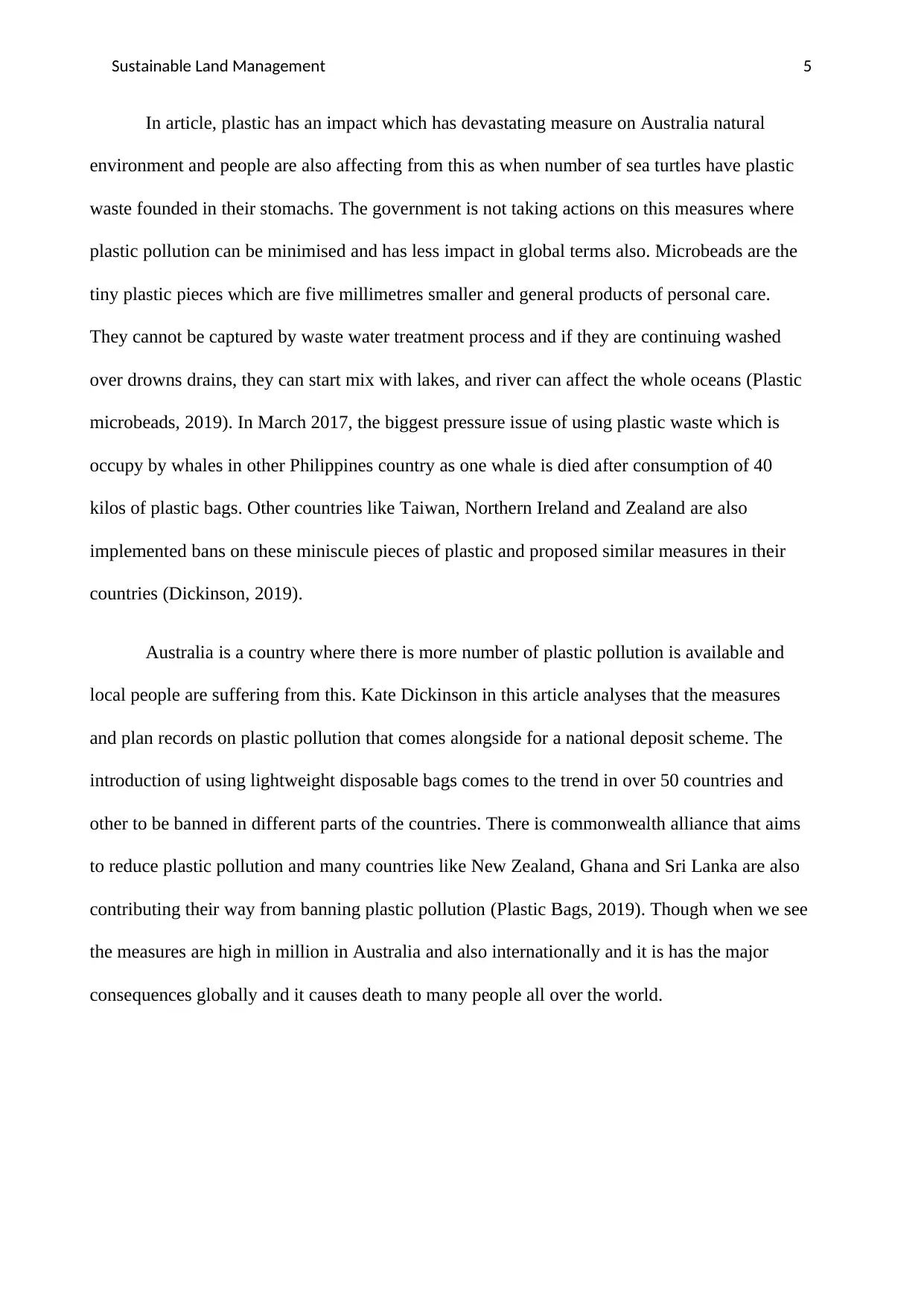
Sustainable Land Management 5
In article, plastic has an impact which has devastating measure on Australia natural
environment and people are also affecting from this as when number of sea turtles have plastic
waste founded in their stomachs. The government is not taking actions on this measures where
plastic pollution can be minimised and has less impact in global terms also. Microbeads are the
tiny plastic pieces which are five millimetres smaller and general products of personal care.
They cannot be captured by waste water treatment process and if they are continuing washed
over drowns drains, they can start mix with lakes, and river can affect the whole oceans (Plastic
microbeads, 2019). In March 2017, the biggest pressure issue of using plastic waste which is
occupy by whales in other Philippines country as one whale is died after consumption of 40
kilos of plastic bags. Other countries like Taiwan, Northern Ireland and Zealand are also
implemented bans on these miniscule pieces of plastic and proposed similar measures in their
countries (Dickinson, 2019).
Australia is a country where there is more number of plastic pollution is available and
local people are suffering from this. Kate Dickinson in this article analyses that the measures
and plan records on plastic pollution that comes alongside for a national deposit scheme. The
introduction of using lightweight disposable bags comes to the trend in over 50 countries and
other to be banned in different parts of the countries. There is commonwealth alliance that aims
to reduce plastic pollution and many countries like New Zealand, Ghana and Sri Lanka are also
contributing their way from banning plastic pollution (Plastic Bags, 2019). Though when we see
the measures are high in million in Australia and also internationally and it is has the major
consequences globally and it causes death to many people all over the world.
In article, plastic has an impact which has devastating measure on Australia natural
environment and people are also affecting from this as when number of sea turtles have plastic
waste founded in their stomachs. The government is not taking actions on this measures where
plastic pollution can be minimised and has less impact in global terms also. Microbeads are the
tiny plastic pieces which are five millimetres smaller and general products of personal care.
They cannot be captured by waste water treatment process and if they are continuing washed
over drowns drains, they can start mix with lakes, and river can affect the whole oceans (Plastic
microbeads, 2019). In March 2017, the biggest pressure issue of using plastic waste which is
occupy by whales in other Philippines country as one whale is died after consumption of 40
kilos of plastic bags. Other countries like Taiwan, Northern Ireland and Zealand are also
implemented bans on these miniscule pieces of plastic and proposed similar measures in their
countries (Dickinson, 2019).
Australia is a country where there is more number of plastic pollution is available and
local people are suffering from this. Kate Dickinson in this article analyses that the measures
and plan records on plastic pollution that comes alongside for a national deposit scheme. The
introduction of using lightweight disposable bags comes to the trend in over 50 countries and
other to be banned in different parts of the countries. There is commonwealth alliance that aims
to reduce plastic pollution and many countries like New Zealand, Ghana and Sri Lanka are also
contributing their way from banning plastic pollution (Plastic Bags, 2019). Though when we see
the measures are high in million in Australia and also internationally and it is has the major
consequences globally and it causes death to many people all over the world.
⊘ This is a preview!⊘
Do you want full access?
Subscribe today to unlock all pages.

Trusted by 1+ million students worldwide
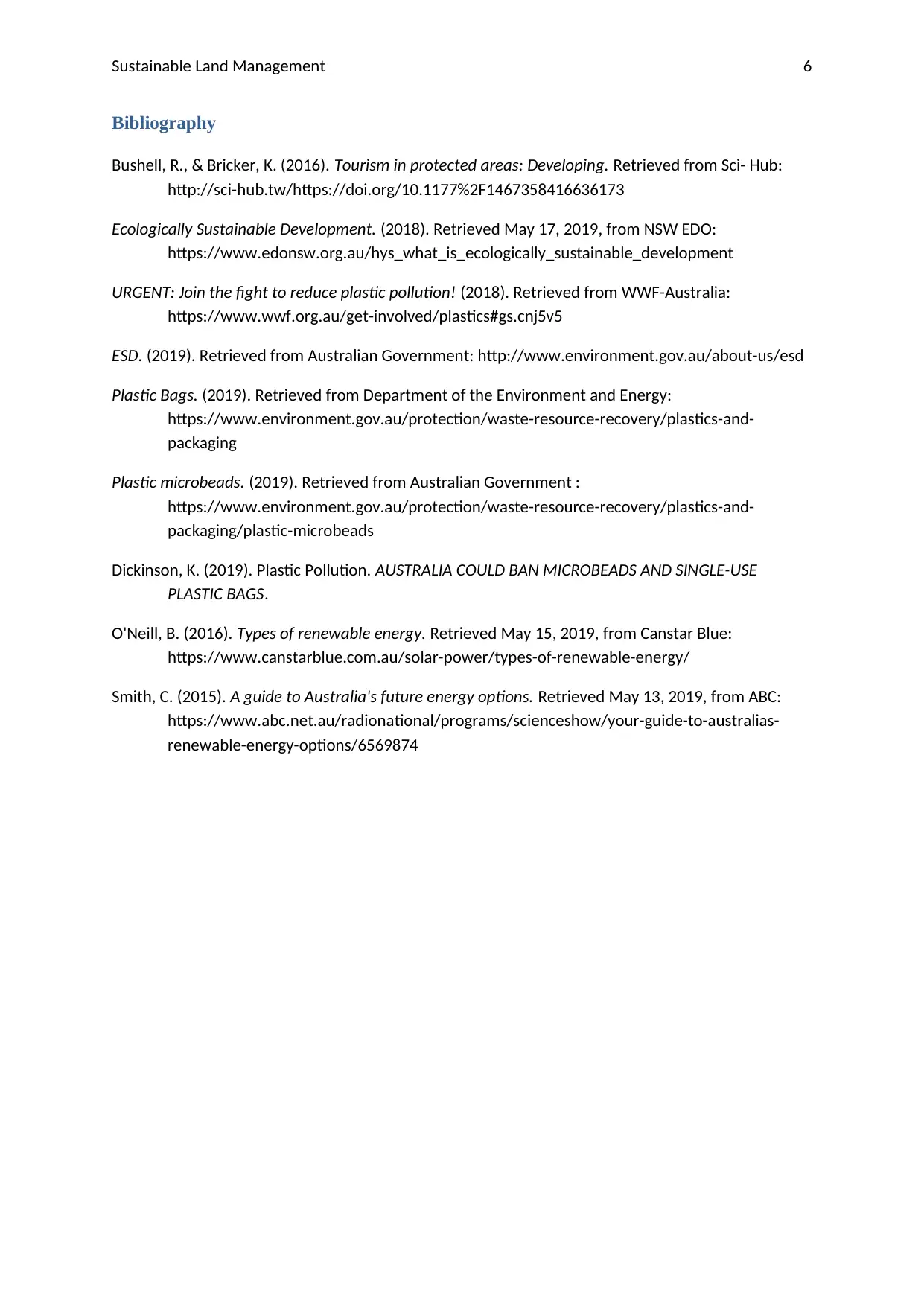
Sustainable Land Management 6
Bibliography
Bushell, R., & Bricker, K. (2016). Tourism in protected areas: Developing. Retrieved from Sci- Hub:
http://sci-hub.tw/https://doi.org/10.1177%2F1467358416636173
Ecologically Sustainable Development. (2018). Retrieved May 17, 2019, from NSW EDO:
https://www.edonsw.org.au/hys_what_is_ecologically_sustainable_development
URGENT: Join the fight to reduce plastic pollution! (2018). Retrieved from WWF-Australia:
https://www.wwf.org.au/get-involved/plastics#gs.cnj5v5
ESD. (2019). Retrieved from Australian Government: http://www.environment.gov.au/about-us/esd
Plastic Bags. (2019). Retrieved from Department of the Environment and Energy:
https://www.environment.gov.au/protection/waste-resource-recovery/plastics-and-
packaging
Plastic microbeads. (2019). Retrieved from Australian Government :
https://www.environment.gov.au/protection/waste-resource-recovery/plastics-and-
packaging/plastic-microbeads
Dickinson, K. (2019). Plastic Pollution. AUSTRALIA COULD BAN MICROBEADS AND SINGLE-USE
PLASTIC BAGS.
O'Neill, B. (2016). Types of renewable energy. Retrieved May 15, 2019, from Canstar Blue:
https://www.canstarblue.com.au/solar-power/types-of-renewable-energy/
Smith, C. (2015). A guide to Australia's future energy options. Retrieved May 13, 2019, from ABC:
https://www.abc.net.au/radionational/programs/scienceshow/your-guide-to-australias-
renewable-energy-options/6569874
Bibliography
Bushell, R., & Bricker, K. (2016). Tourism in protected areas: Developing. Retrieved from Sci- Hub:
http://sci-hub.tw/https://doi.org/10.1177%2F1467358416636173
Ecologically Sustainable Development. (2018). Retrieved May 17, 2019, from NSW EDO:
https://www.edonsw.org.au/hys_what_is_ecologically_sustainable_development
URGENT: Join the fight to reduce plastic pollution! (2018). Retrieved from WWF-Australia:
https://www.wwf.org.au/get-involved/plastics#gs.cnj5v5
ESD. (2019). Retrieved from Australian Government: http://www.environment.gov.au/about-us/esd
Plastic Bags. (2019). Retrieved from Department of the Environment and Energy:
https://www.environment.gov.au/protection/waste-resource-recovery/plastics-and-
packaging
Plastic microbeads. (2019). Retrieved from Australian Government :
https://www.environment.gov.au/protection/waste-resource-recovery/plastics-and-
packaging/plastic-microbeads
Dickinson, K. (2019). Plastic Pollution. AUSTRALIA COULD BAN MICROBEADS AND SINGLE-USE
PLASTIC BAGS.
O'Neill, B. (2016). Types of renewable energy. Retrieved May 15, 2019, from Canstar Blue:
https://www.canstarblue.com.au/solar-power/types-of-renewable-energy/
Smith, C. (2015). A guide to Australia's future energy options. Retrieved May 13, 2019, from ABC:
https://www.abc.net.au/radionational/programs/scienceshow/your-guide-to-australias-
renewable-energy-options/6569874
1 out of 7
Related Documents
Your All-in-One AI-Powered Toolkit for Academic Success.
+13062052269
info@desklib.com
Available 24*7 on WhatsApp / Email
![[object Object]](/_next/static/media/star-bottom.7253800d.svg)
Unlock your academic potential
Copyright © 2020–2025 A2Z Services. All Rights Reserved. Developed and managed by ZUCOL.





